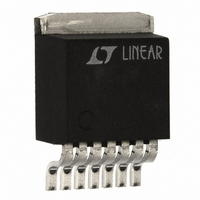LT1370HVCR Linear Technology, LT1370HVCR Datasheet - Page 8

LT1370HVCR
Manufacturer Part Number
LT1370HVCR
Description
IC SWTCHNG REG 6A HI-EFF 7-DD
Manufacturer
Linear Technology
Type
Step-Down (Buck), Step-Up (Boost), Inverting, Cuk, Flyback, Forward Converterr
Datasheet
1.LT1370CRPBF.pdf
(16 pages)
Specifications of LT1370HVCR
Internal Switch(s)
Yes
Synchronous Rectifier
No
Number Of Outputs
1
Voltage - Output
1.25 ~ 42 V
Current - Output
6A
Frequency - Switching
500kHz
Voltage - Input
2.7 ~ 25 V
Operating Temperature
0°C ~ 70°C
Mounting Type
Surface Mount
Package / Case
D²Pak, TO-263 (7 leads + tab)
Lead Free Status / RoHS Status
Contains lead / RoHS non-compliant
Power - Output
-
Available stocks
Company
Part Number
Manufacturer
Quantity
Price
Part Number:
LT1370HVCR#PBF
Manufacturer:
LINEAR/凌特
Quantity:
20 000
Part Number:
LT1370HVCR#TRPBF
Manufacturer:
LINEAR/凌特
Quantity:
20 000
APPLICATIO S I FOR ATIO
LT1370
Shutdown and Synchronization
The device has a dual function S/S pin which is used for
both shutdown and synchronization. This pin is logic level
compatible and can be pulled high, tied to V
floating for normal operation. A logic low on the S/S pin
activates shutdown, reducing the part’s supply current to
12µA. Typical synchronization range is from 1.05 to 1.8
times the part’s natural switching frequency, but is only
guaranteed between 600kHz and 800kHz. A 12µs resetable
shutdown delay network guarantees the part will not go
into shutdown while receiving a synchronization signal.
Caution should be used when synchronizing above 700kHz
because at higher sync frequencies the amplitude of the
internal slope compensation used to prevent subhar-
monic switching is reduced. This type of subharmonic
switching only occurs when the duty cycle of the switch
is above 50%. Higher inductor values will tend to elimi-
nate this problem.
Thermal Considerations
Care should be taken to ensure that the worst-case input
voltage and load current conditions do not cause exces-
sive die temperatures. Typical thermal resistance is
30°C/W for the R package and 50°C/W for the T7 package
but these numbers will vary depending on the mounting
techniques (copper area, airflow, etc.). Heat is transferred
from the package via the tab.
Average supply current (including driver current) is:
Switch power dissipation is given by:
Total power dissipation of the die is the sum of supply
current times supply voltage, plus switch power:
8
I
I
DC = Switch duty cycle
P
R
P
IN
SW
SW
D(TOTAL)
SW
= 4.5mA + DC(I
= Switch current
= (I
= Output switch ON resistance
SW
= (I
)
2
(R
IN
SW
)(V
U U
)(DC)
IN
SW
) + P
/45)
SW
W
IN
U
or left
Surface mount heat sinks are available which can lower
package thermal resistance by two or three times. One
manufacturer, Wakefield Engineering, offers surface mount
heat sinks for the R package and can be reached at (617)
245-5900 or at www.wakefield.com.
Choosing the Inductor
For most applications the inductor will fall in the range of
2.2µH to 22µH. Lower values are chosen to reduce physi-
cal size of the inductor. Higher values allow more output
current because they reduce peak current seen by the
power switch, which has a 6A limit. Higher values also
reduce input ripple voltage and reduce core loss.
When choosing an inductor you need to consider maxi-
mum load current, core and copper losses, allowable
component height, output voltage ripple, EMI, fault
current in the inductor, saturation and, of course, cost.
The following procedure is suggested as a way of handling
these somewhat complicated and conflicting requirements.
1. Assume that the average inductor current for a boost
2. Calculate peak inductor current at full load current to
converter is equal to load current times V
decide whether or not the inductor must withstand
continuous overload conditions. If average inductor
current at maximum load current is 3A, for instance, a
3A inductor may not survive a continuous 6A overload
condition. Also be aware that boost converters are not
short-circuit protected and that, under output short
conditions, inductor current is limited only by the
available current of the input supply.
ensure that the inductor will not saturate. Peak current
can be significantly higher than output current, espe-
cially with smaller inductors and lighter loads, so don’t
omit this step. Powdered iron cores are forgiving
because they saturate softly, whereas ferrite cores
saturate abruptly and other core materials fall in
between. The following formula assumes continuous
mode operation but it errs only slightly on the high side
for discontinuous mode, so it can be used for all
conditions.
OUT
sn1370 1370fs
/ V
IN
and













